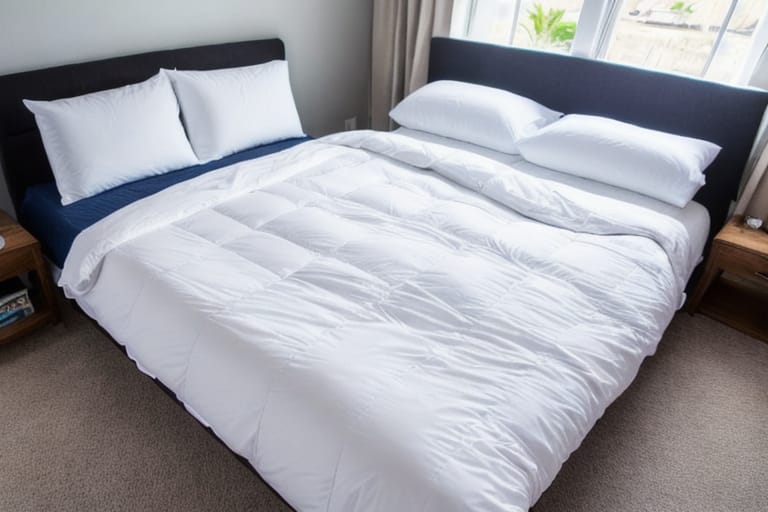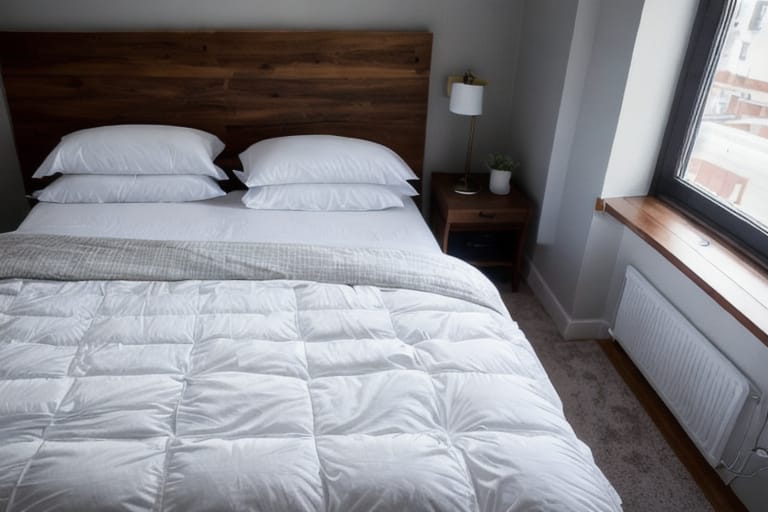Down duvets seem like something straight out of a fairytale. With their ethereal softness and cloud-like comfort, it’s no wonder these luxurious bed covers hold such timeless appeal. But like any product dependent on animal-derived materials, down duvets have sparked much ethical debate.
So are down duvets cruel? In short – it depends. Traditional harvesting methods often involve painful procedures like live-plucking. But with growing consumer awareness and industry advancements, it’s now possible to source responsibly produced and cruelty-free down through humane standards and certifications.
Let’s take a deeper look at the complex issues surrounding down production and standards for ethical sourcing. We’ll also explore some sustainable alternatives to traditional down – from innovative synthetics to plant-based fills. You can sleep soundly knowing all the details when choosing your next duvet.
What are Down Duvets Really Made Of?
As the name suggests, down duvets are filled with down feathers – the super-soft, fluffy clusters found underneath the exterior feathers of ducks and geese. These are actually a thermal insulating undercoat that keeps birds warm.
Comprising only around 10% of all feathers, down is prized for its impressive heat retention and lightweight loft. This gives duvets their signature cloud-like feel and gentle weight. Down also has superior durability – able to endure years of compression and spring back to full loft when fluffed.
Goose down is generally softer, warmer and more insulating than duck down – but also more expensive. Duck down offers great performance at a lower cost.
| Type | Pros | Cons | Cost |
|---|---|---|---|
| Goose Down | Very warm & soft | More expensive | $$$$ |
| Duck Down | Affordable, good insulation | Less fluffy | $$ |
So with such desirable properties, it’s no wonder down fills fetch a premium in the bedding market. But how are the feathers actually sourced?
The Ugly Truth: Live-Plucking and Force-Feeding
Here’s where major ethical issues emerge. Up to 80% of the world’s down may come from China – and lax regulations mean cruel practices often slide under the radar. The two biggest concerns are:
1. Painful Live-Plucking
- Farms pluck feathers from conscious, living birds
- Causes cuts, bruises and stress
- Performed repeatedly to maximize feather yield
2. Gavage for Foie Gras Production
- Ducks/geese force-fed via pipes to fatten their livers
- Creates disease-prone fatty liver pâté (foie gras)
- Spin-off effect provides feathers for down
Unregulated Chinese farms provide cheap down for export using these methods. But consumer backlash is growing…
“We believe procurement of down should never involve unnecessary harm to animals.”
– Hilary Ross, Senior Director of Sourcing at ALDI US.
In response, more brands now pledge to avoid cruel practices – adopting ethical standards instead.
Upholding Animal Welfare: Industry Standards for Humane Practices

Multiple certification programs now help regulate the down supply chain for animal welfare:
Responsible Down Standard (RDS)
- Most widely adopted global standard
- Certifies no live-plucking or force-feeding
- Sets standards for animal welfare including shelter, space and handling
Global Traceable Down Standard (GTDS)
- Builds on RDS with full supply chain traceability
- Follows down from farm to final product
- Allows brands to market 100% Traceable Down
Together with standardized testing, these help provide ethical assurance to brands and consumers. Expect to see logos indicating certified sources.
Guilt-Free Alternatives to Down Duvets
For total peace of mind, more consumers now opt for down-alternative duvets with no animal inputs:
High-Tech Synthetic Fills
- PrimaLoft® and MicroTERY® mimic warmth and loft of down
- Made from synthetic fibers and proprietary methods
- Hypoallergenic and odor/stain resistant
Natural Materials like Eucalyptus
- Derived from FSC-certified eucalyptus pulp
- Naturally breathable and biodegradable
- Generous loft and insulating abilities
While not matching the loft of fine down, these provide cruelty-free comfort with low environmental impact. It’s an easier choice for vegan or ethical shoppers. Brands like Buffy now lead the way on innovative down alternatives.
Reusing Existing Down Supplies
A small but growing trend is emerging around recycled down from pre-used textiles. For example:
- Re:Down® by NEMO recycles down and feathers from end-of-life garments. These are then sterilized and re-used as fill material.
- RippleTM fill blends recycled down and feathers with other sustainably sourced bio-based materials.
Conceptually this makes use of resources already in circulation – extending product lifecycles without further impacts. But scaling and processing remains challenging compared to virgin down streams.
Is Down More Sustainable Than We Thought?
There are some nuances in down’s total environmental impact too.
Viewed holistically, down is a by-product of the food industry. As geese and ducks are reared for meat, the feathers accumulate as waste. So channeling this into duvets and jackets could be seen as an efficient reuse of resources. It’s the same logic behind leather from beef cattle.
And unlike synthetic alternatives, down is all-natural, biodegradable and also long-lasting in use. So by avoiding petrochemicals and waste in landfills, down could score points for sustainability. It would just need far stronger animal welfare practices across sourcing regions.
What’s the Cost of Responsible Down Bedding?

As you might expect, ethical down meeting certification standards costs more to produce. The chart below compares queen/king duvet prices across different fills and brands:
| Fill Material | Brand | Price |
|---|---|---|
| Goose Down (RDS) | Boll & Branch | $248-$298 |
| Duck Down Blend (RDS) | Buffy | $160-$180 |
| Eucalyptus Down Alternative | Buffy | $120-$140 |
| Recycled Goose Down | NEMO Equipment | $199 |
| PrimaLoft® Synthetic | Eddie Bauer | $99-$130 |
Pricing reflects the sourcing, processing and overall quality of each fill type. But you are paying explicitly for assurances around ethical harvesting and animal welfare. For some this brings worthwhile peace of mind.
Media Spotlight Pressures Brands to Improve
Hard-hitting exposés have catalyzed consumer concern around down production:
- A 2009 Swedish TV documentary showed disturbing scenes of live-plucking in China. This prompted many fashion retailers to update sourcing policies.
- More recently, the 2021 film “Eating our Way to Extinction” linked down to force-feeding in foie gras production.
Together these build public awareness and consumer pressure for higher standards. And popular brands respond…
“We do not condone or tolerate the inhumane treatment of animals… Our stakeholders rightly hold us accountable to higher standards of transparency and ethics.” – Christy Dawn, fashion label
Shoppers Want Cruelty-Free: But Provenance is Complex
Surveys indicate growing demand for ethical and environmentally-conscious apparel and homewares. But complex supply chains mean brands struggle to fully validate claims.
- 75% of millennials expect brands to publicly demonstrate ethical practices and progress.
- However 90% of goods have incomplete or inaccurate data trails.
So while sourcing certified down is progress, full traceability of each small cluster back the bird’s origin remains a huge challenge. Technologies like forensic isotopic testing and blockchain ledgers could strengthen future transparency.
Healthier and More Ethical: The Future of Down
Consumer awareness has pushed the down industry to a tipping point. Brands now choose between two paths:
The High Road: Adopting certified sources plus innovations like:
- Transparent supply chains with digital tracing
- Hybrid duvets blending down with recycled synthetics
- Processing for hypoallergenic, anti-microbial properties
The Low Road: Continuing lax and harmful sourcing simply to maximize profits. But this risks damaging their brand through consumer avoidance and tighter regulations.
Those investing in the high road will see reputational gains and open new market opportunities. Ultimately this helps accelerate better standards for human health and animal welfare alike.
So while past down production had cruel implications, I’m optimistic for kinder practices and guilt-free comfort in the future. Vote with your wallet and support the sustainable innovators leading industry change.
Frequently Asked Questions
What is the difference between duck down and goose down?
Goose down tends to be softer, warmer, and provide better insulation. However, it is also more expensive. Duck down offers great performance and durability at a lower cost. Choose goose down for maximum loft and comfort or opt for duck down to save money.
Is down ethically sourced from the food industry?
Sometimes yes, sometimes no. As byproducts from meat production, down and feathers can be seen as efficient reuse of resources. However issues arise from unregulated farms focused heavily on down/feather output. Opting for responsibly sourced down helps encourage higher animal welfare standards.
Why is certified down more expensive?
Ethical down certification programs like Responsible Down Standard (RDS) and Global Traceable Down Standard (GTDS) require more humane practices and supply chain transparency. This increased oversight and assurance results in higher production costs. As consumer demand grows, prices should become more competitive.
Are down alternatives better for allergies?
Hypoallergenic synthetic fills made from polyester or PrimaLoft® fibers have an advantage for allergy sufferers. With no animal proteins which can trigger sensitivities, these provide a healthier solution without downsides like allergenic dust mites.
Is recycled down as warm as virgin down?
Recycled down offers comparable thermal performance to virgin down in most cases. Advanced processing removes debris and sterilizes clusters for hypoallergenic properties too. Blending small amounts of high-quality recycled down into other sustainable materials helps maximize both warmth and responsible sourcing.
How can I identify ethical down products to buy?
Check item labels and packaging for credibly certified down. Logos like Responsible Down Standard (RDS) and Global Traceable Down Standard (GTDS) indicate humane treatment. Recycled down programs like Re:Down® also provide cruelty-free options. And synthetic fills guarantee completely animal-free production.








